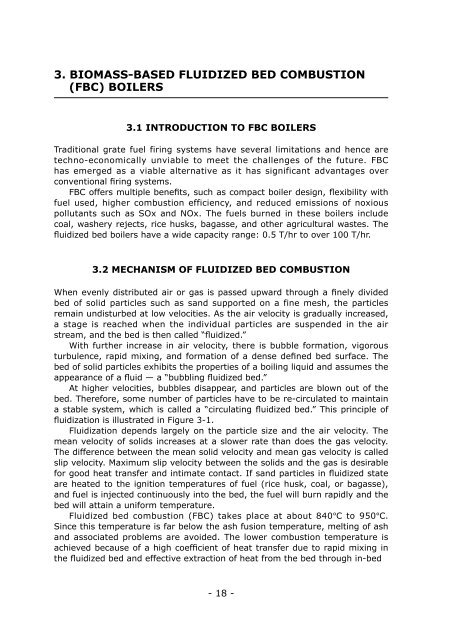Biomass as Fuel in Small Boilers (PDF 6.4 - APO Asian Productivity ...
Biomass as Fuel in Small Boilers (PDF 6.4 - APO Asian Productivity ...
Biomass as Fuel in Small Boilers (PDF 6.4 - APO Asian Productivity ...
You also want an ePaper? Increase the reach of your titles
YUMPU automatically turns print PDFs into web optimized ePapers that Google loves.
3. BIOMASS-BASED FLUIDIZED BED COMBUSTION<br />
(FBC) BOILERS<br />
3.1 INTRODUCTION TO FBC BOILERS<br />
Traditional grate fuel fir<strong>in</strong>g systems have several limitations and hence are<br />
techno-economically unviable to meet the challenges of the future. FBC<br />
h<strong>as</strong> emerged <strong>as</strong> a viable alternative <strong>as</strong> it h<strong>as</strong> significant advantages over<br />
conventional fir<strong>in</strong>g systems.<br />
FBC offers multiple benefits, such <strong>as</strong> compact boiler design, flexibility with<br />
fuel used, higher combustion efficiency, and reduced emissions of noxious<br />
pollutants such <strong>as</strong> SOx and NOx. The fuels burned <strong>in</strong> these boilers <strong>in</strong>clude<br />
coal, w<strong>as</strong>hery rejects, rice husks, bag<strong>as</strong>se, and other agricultural w<strong>as</strong>tes. The<br />
fluidized bed boilers have a wide capacity range: 0.5 T/hr to over 100 T/hr.<br />
3.2 MECHANISM OF FLUIDIZED BED COMBUSTION<br />
When evenly distributed air or g<strong>as</strong> is p<strong>as</strong>sed upward through a f<strong>in</strong>ely divided<br />
bed of solid particles such <strong>as</strong> sand supported on a f<strong>in</strong>e mesh, the particles<br />
rema<strong>in</strong> undisturbed at low velocities. As the air velocity is gradually <strong>in</strong>cre<strong>as</strong>ed,<br />
a stage is reached when the <strong>in</strong>dividual particles are suspended <strong>in</strong> the air<br />
stream, and the bed is then called “fluidized.”<br />
With further <strong>in</strong>cre<strong>as</strong>e <strong>in</strong> air velocity, there is bubble formation, vigorous<br />
turbulence, rapid mix<strong>in</strong>g, and formation of a dense def<strong>in</strong>ed bed surface. The<br />
bed of solid particles exhibits the properties of a boil<strong>in</strong>g liquid and <strong>as</strong>sumes the<br />
appearance of a fluid — a “bubbl<strong>in</strong>g fluidized bed.”<br />
At higher velocities, bubbles disappear, and particles are blown out of the<br />
bed. Therefore, some number of particles have to be re-circulated to ma<strong>in</strong>ta<strong>in</strong><br />
a stable system, which is called a “circulat<strong>in</strong>g fluidized bed.” This pr<strong>in</strong>ciple of<br />
fluidization is illustrated <strong>in</strong> Figure 3-1.<br />
Fluidization depends largely on the particle size and the air velocity. The<br />
mean velocity of solids <strong>in</strong>cre<strong>as</strong>es at a slower rate than does the g<strong>as</strong> velocity.<br />
The difference between the mean solid velocity and mean g<strong>as</strong> velocity is called<br />
slip velocity. Maximum slip velocity between the solids and the g<strong>as</strong> is desirable<br />
for good heat transfer and <strong>in</strong>timate contact. If sand particles <strong>in</strong> fluidized state<br />
are heated to the ignition temperatures of fuel (rice husk, coal, or bag<strong>as</strong>se),<br />
and fuel is <strong>in</strong>jected cont<strong>in</strong>uously <strong>in</strong>to the bed, the fuel will burn rapidly and the<br />
bed will atta<strong>in</strong> a uniform temperature.<br />
Fluidized bed combustion (FBC) takes place at about 840 ºC to 950 ºC.<br />
S<strong>in</strong>ce this temperature is far below the <strong>as</strong>h fusion temperature, melt<strong>in</strong>g of <strong>as</strong>h<br />
and <strong>as</strong>sociated problems are avoided. The lower combustion temperature is<br />
achieved because of a high coefficient of heat transfer due to rapid mix<strong>in</strong>g <strong>in</strong><br />
the fluidized bed and effective extraction of heat from the bed through <strong>in</strong>-bed<br />
- 18 -
















